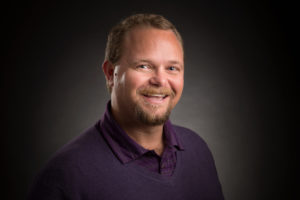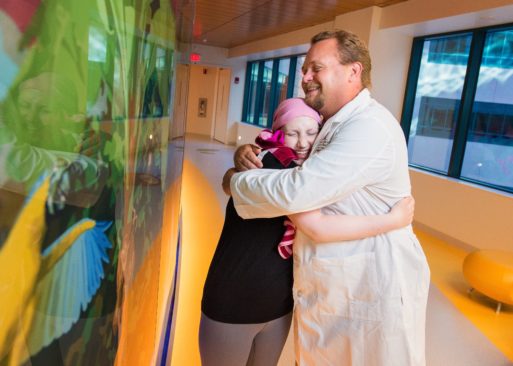Today SevenPonds speaks with Dr. Justin Baker, M.D., Faculty Chief of the Division of Quality of Life and Palliative Care at St. Jude’s Children’s Research Hospital in Memphis, Tennessee. Originally trained as a pediatric oncologist, Dr. Baker later transitioned to pediatric palliative care and helped establish the first pediatric palliative care team at St. Jude’s. Dr. Baker is also the director of the St. Jude’s Pediatric Oncology/Hematology fellowship program and continues to treat patients as an attending physician on both the Oncology and Quality of Life services at St. Jude’s.
Editor’s note: This interview has been edited for length and clarity.

Credit: St. Jude’s Children’s Research Hospital
Kathleen Clohessy: Hi, Dr. Baker. Thanks so much for speaking with me today.
Dr. Justin Baker: My pleasure.
Kathleen: Can you begin by telling me a little about your background? How did you become interested in pediatric oncology and palliative care?
Dr. Baker: I always knew I wanted to practice pediatric medicine, but after my grandmother died of cancer I gravitated towards oncology. I also had the good fortune of having an incredible mentor, Dr. Javier Kane, a pediatric oncologist/hematologist who was one of the pioneers in pediatric palliative care. Working alongside him, I developed a strong interest in helping to improve the quality of life of our pediatric cancer patients. I became Board Certified in Hospice and Palliative Care medicine and soon after that we began laying the groundwork for the QOL service at St Jude’s.
Kathleen: Was it difficult to introduce the concept of a palliative care service to the oncology team and hospital administrators? Did you meet much resistance at first?
Dr. Baker: Oh yes, it was a huge uphill battle. St. Jude’s slogan is “Finding Cures. Saving Children.” So the focus here has always been on developing treatment protocols that are meant to cure disease and extend children’s lives. And, of course, the palliative care model can and often does include that kind of care. About 60 percent of patients on the Quality of Life service are receiving curative treatment at the same time as palliative care.
Still, shifting the focus to not just saving lives but improving the quality of life for seriously ill children and their families wasn’t an easy task. Dr. Kane and his associate, nurse researcher Pam Hinds, were the driving force behind the paradigm shift. They were my research and clinical mentors from 2010 to 2011, when the Quality of Life service at St. Jude’s began.
Kathleen: What types of patients do you see on your service? Is it limited to children with cancer or do you care for children with other life-threatening illnesses too?
Dr. Baker: The vast majority of our patients have a cancer diagnosis. But we also treat kids with other catastrophic conditions, such as sickle cell disease and adolescents with HIV/AIDS. Fortunately, the number of AIDS patients we see today is very small.
Kathleen: Does your team see every oncology patient or only those who are referred to you?
Dr. Baker: We try to see as many patients as we can, but we don’t see everyone. We have about 600 pediatric cancer patients in total, and we get about 200 to 250 new consults every month. As a rule, we have about 150 patients on our service at one time.
That said, we do see every patient who we identify as “high-risk.” That includes every bone marrow transplant patient, every patient in the ICU, children with brain tumors and any patient who is likely to die within a short period of time.

Dr. Baker gets a hug from a cancer patient in the hallway at St. Jude’s
Credit: St. Jude’s Children’s Research Hospital
Kathleen: What does your palliative care model look like? Are patients and families seen only when they’re in the hospital?
Dr. Baker: No, not at all. Many of our patients and families are seen as outpatients by our home-care team. St. Jude’s owns almost 100 apartments in Memphis where patients and their families live while receiving care. Our goal is to allow the children to stay in the home environment as much as possible, so we provide as much care there as we can. That can include things like giving pain medication or teaching the family how to use a PCA [patient controlled analgesia]; drawing labs; dealing with insurance issues or simply talking to the family and helping them cope with what’s going on.
Kathleen: What types of professionals are on your team?
Dr. Baker: We’re a multidisciplinary team. In addition to four attending physicians, we have a psychologist, five nurse practitioners, registered nurses, social workers and two program coordinators. It’s a huge group! That’s one of the reasons why we recently implemented a new home care model in which each of our five nurse practitioners works with patients who have similar diagnoses or are undergoing similar kinds of care. So, for example, we have one NP who works with the bone marrow transplant patients, one NP who works with neuro [brain tumor] patients, and so on. We’re finding it really improves communication between team members to have one person overseeing the care of patients and families who have similar needs. And instead of the whole team, the home visit can include only the providers who can best meet the patient’s needs at the time.
Kathleen: Does your team provide hospice care?
We do provide end-of-life care, which incorporates the elements of hospice. But we aim to make the process seamless for the patient and the family. What that means from a practical standpoint is that, as the trajectory of the child’s illness changes or the prognosis worsens, the goals of care change. But the same team members remain involved in the patient’s care. There’s no point at which we declare,“OK, you’re in hospice now” and a different service takes over.
This concludes part one of our interview with Dr. Justin Baker. Please come back next week when we will be discussing how bereaved parents have helped shape the Quality of Life program at St. Jude’s.

 What Is Pediatric Palliative Care?
What Is Pediatric Palliative Care?


 First the Wealth Gap, Now the U.S. Has a Growing Health Gap
First the Wealth Gap, Now the U.S. Has a Growing Health Gap

 Our Annual Seven Holiday Gifts for Someone Who Is Grieving, 2024 Edition
Our Annual Seven Holiday Gifts for Someone Who Is Grieving, 2024 Edition














